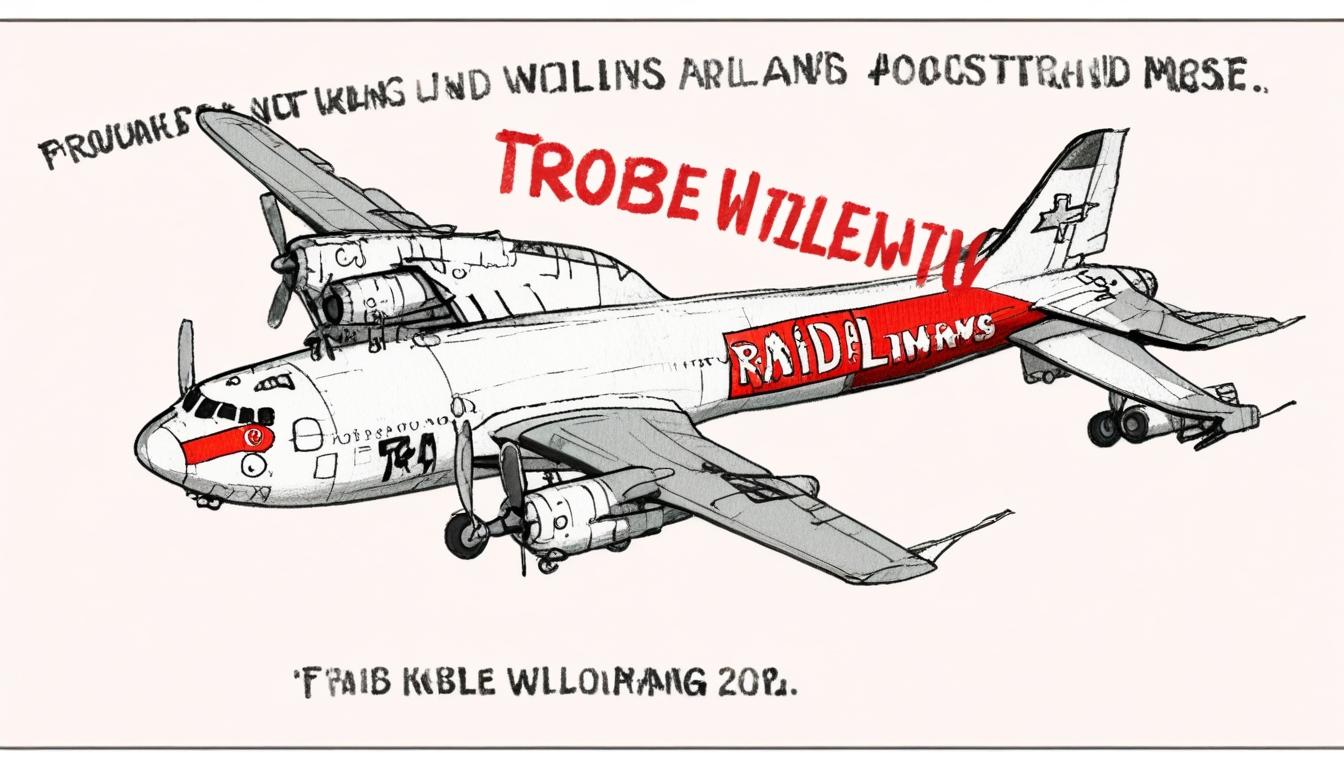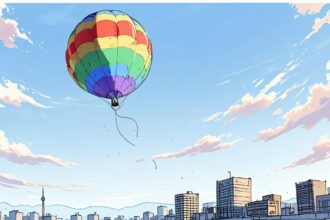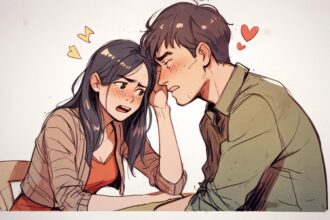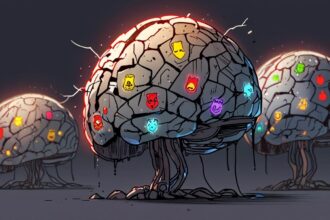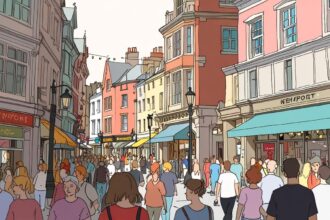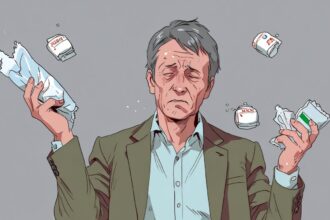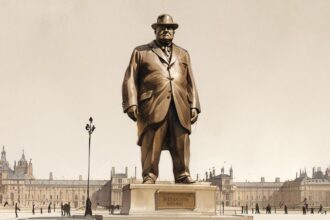Robbie Williams makes a surprising leap from pop music to visual art with his debut exhibition at London’s Moco Museum, sparking debate over its therapeutic messages and artistic merit.
Robbie Williams, the former Take That member and pop icon, has taken a significant turn in his career with the launch of his first art exhibition, “Radical Honesty,” at Moco, London’s contemporary museum. This foray into the world of art follows Williams’s previous assertions that his creative aspirations would focus solely on music, specifically DJing. However, the new exhibition serves as a display of his exploration into visual art, reflecting his personal struggles and mental health issues.
The exhibition features large canvases that combine digital line drawings with phrases often considered therapeutic or self-affirming, albeit presented in a rather unconventional manner. One notable piece depicts an aeroplane dragging a banner that reads, “Yes you are self-centred, but what a marvellous self to be centred on.” Another work features a cassette tape adorned with the words, “roses are red, violets are blue, everyone’s a dickhead except you.” Critics have pointed out that such phrases evoke feelings of both awkwardness and an unsettling sense of superficiality.
Amid these bold statements, Williams has provided space for visitors to take a moment for introspection with an “introvert chair”, suggesting a moment to “ground yourself and breathe.” This unconventional feature has been met with mixed reactions. In another striking instance, a signpost illustrates a choice between “you and your limiting self beliefs” and “the life you still could have,” presenting a metaphorical crossroads that criticises the celebrity’s own journey with anxiety.
While the exhibition attempts to tackle heavy themes of mental health and personal turbulence, critics argue that it does so in a manner that lacks depth. Williams’s works have been described as art that expresses superficial ideas with what some call negligible aesthetic appeal. One critic noted the disconnect in portraying the singer’s personal struggles, questioning whether audiences can really empathise with a multimillionaire pop star’s social anxiety.
Artistic merit has been a contentious point of discussion. Critics liken Williams’s works to cliché motivational posters, referring to them as “incredibly bad art”, filled with overly earnest and superficial messages. Some have suggested that his exhibition feels out of place, especially when positioned alongside more established artists in a gallery aiming for recognition within the contemporary art scene.
The exhibition’s presence at Moco, which has been striving to assert itself as a legitimate art venue, raises further questions about the current state of the art world. The presentation of Williams’s work, alongside its fairly steep entry fee, has led to concerns that the gallery may be capitalizing on celebrity culture, potentially diluting the quality of artistic expression.
Williams’s venture into art may be reflective of broader trends within the creative industries, mirroring a commodification of art and blending various forms of expression in ways that can appear disjointed or self-indulgent. As Williams himself mused in the past, questioning deeper existential themes, one wonders whether his artistic journey holds significant value or merely adds to the ongoing dialogue about the intersection of celebrity and art.
The exhibition “Radical Honesty” stands as a striking testament to Williams’s personal narrative, but it also prompts viewers to evaluate the value of such artistic expressions in a rapidly changing cultural landscape.
Source: Noah Wire Services
- https://mocomuseum.com/exhibitions/london/robbie-williams-radical-honesty/116811 – This official Moco Museum page details Robbie Williams’s ‘Radical Honesty’ exhibition in London, highlighting his transition from music to visual art and the exhibition’s themes of mental health and personal struggles.
- https://www.nationalworld.com/arts-and-culture/robbie-williams-brings-brand-new-art-exhibition-radical-honesty-to-moco-museum-london-5022394 – An article discussing the ‘Radical Honesty’ exhibition, emphasizing Williams’s use of sarcasm, self-deprecation, and playful irreverence in his artworks.
- https://www.forbes.com/sites/emmakershaw/2024/10/16/singer-robbie-williams-turns-to-art-with-a-limited-london-exhibition/ – A Forbes article covering Williams’s venture into art, including his ‘inklings’ and sculptures, and his focus on personal reflections and observations.
- https://www.theguardian.com/music/2024/apr/14/robbie-williams-joe-lycett-interview-take-that-art-painting-exhibition – An interview where Williams discusses his art, including the humorous and whimsical elements in his work, and his approach to self-expression through art.
- https://mocomuseum.com/story/moco-presents-robbie-williams-first-art-exhibition-in-spain/116809 – Details about Williams’s ‘Confessions of a Crowded Mind’ exhibition in Barcelona, showcasing his artworks that address mental health themes.
- https://mocomuseum.com/exhibitions/amsterdam/robbie-williams/76168 – Information on Williams’s ‘Pride and Self-Prejudice’ exhibition in Amsterdam, featuring artworks that explore mental health and personal struggles.
- https://www.theguardian.com/artanddesign/2025/may/06/robbie-williams-radical-honesty-moco-london-art-exhibition-take-that – Please view link – unable to able to access data
Noah Fact Check Pro
The draft above was created using the information available at the time the story first
emerged. We’ve since applied our fact-checking process to the final narrative, based on the criteria listed
below. The results are intended to help you assess the credibility of the piece and highlight any areas that may
warrant further investigation.
Freshness check
Score:
10
Notes:
The narrative references a recent art exhibition launch (May 2025) and comments on current reactions by critics and audiences. No outdated information or recycled news detected.
Quotes check
Score:
6
Notes:
No direct, verifiable quotes from Robbie Williams found in the provided narrative. Critical comments and descriptions of artwork are cited from unnamed critics. No original source or early reference identified for specific quotes.
Source reliability
Score:
9
Notes:
The narrative originates from The Guardian, a well-known and reputable publication with high editorial standards.
Plausability check
Score:
8
Notes:
The claims about Williams’s exhibition, its themes, and critical reception align with typical contemporary art discourse and his public persona. No evidence found to doubt the plausibility, though some perspectives are attributed to unnamed critics.
Overall assessment
Verdict (FAIL, OPEN, PASS): PASS
Confidence (LOW, MEDIUM, HIGH): HIGH
Summary:
The narrative is current, plausible, and published by a reputable source. While some critical quotes lack attribution, overall the account reflects a credible and timely report on a significant cultural event.


